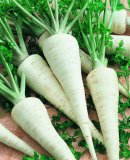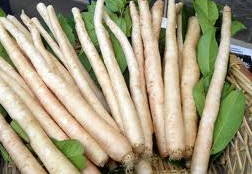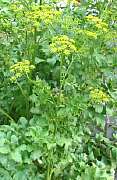~ Parsnips, Root Chicory & Root Parsley ~
Parsnip seed is at the bottom of the page. But as you scroll down,
do consider the other two exciting plants we have here that are used very similarly.
These rare varieties of parsley and chicory have been bred over the centuries for their tasty roots.
~ ROOT PARSLEY ~
Root Parsley is a new discovery for us that we are hoping you will all try out as it is really nice, cold-hardy, and easy to grow.
Root Parsley is normal parsley that has been bred to give a nice white root like a carrot. It has a mild flavour and is slightly sweet. We like this because it is easily grown, and stands overwinter, so it can help with your spring food supply for not much effort. And - you can still use the leaves like normal parsley!
In Czechia, they eat 100,000 tons a year. We found a research paper comparing the taste, storage and growth of many different varieties, and we offer one that was among the very best:

"Atika" Root Parsley
A great modern variety from the former national plant breeding research station in the Czech Republic. It was bred for disease resistance, earliness, and fast root growth even in damp conditions.
The roots are carrot-shaped, about 22cm long, and have a white skin. They are cooked just like carrots and are very easy to grow - sow direct in a seedbed from March onwards - if you can grow normal parsley (which is pretty easy) you can grow this.
A tasty veg you should all try!
![]() 1.2g of seed (plenty) £
1.2g of seed (plenty) £
Small screen: Turn your device sideways to view sowing calendar.






















































~ Root-Chicory Seed ~
Root Chicory is a special type of chicory that has been bred to give a nice white root used much like parsnip.
"Chiavari" Root Chicory

Here is a rare and very special type of chicory from Liguria in the north of Italy, which has been bred not for its leaves, but instead for its long conical roots (much like a parsnip) which are used as a vegetable - boiled, mashed or roasted.
According to our book "The Vegetables, Fruit & Herbs of Italy, by Giacomo Castelvetro" (published in 1614!), for best flavour you should slice the roots lengthwise and cut out its ‘anima’ or soul! (which nowadays we call the core). Then cook just like a carrot or parsnip.
Chicory is very hardy and pretty easy to grow, so this should do well in most places. Sow it just like any other chicory, in early summer, for digging up the roots in autumn/winter.
Another adventurous veg for those who like to try something new!
![]() lots of seed
£
lots of seed
£
Small screen: Turn your device sideways to view sowing calendar.






















































~ PARSNIP Seed ~
 'Tender
& True' Parsnip
'Tender
& True' Parsnip
A very well known traditional parsnip variety making large, strongly-flavoured conical white roots (much as you would expect from a parsnip, really!).
Our late friend Tony Haigh (who bred the wonderful Gardeners' Ecstacy tomato) was very fond of them, and tended to put them in everything, from curry to quiche. While this is a fantastic parsnip, we are not completely convinced about this, and think they are best roasted in the normal manner.
First roots ready from late August onwards, but we usually keep them in the ground until later in the year.
 nice organic seed
£
nice organic seed
£
Small screen: Turn your device sideways to view sowing calendar.




















































Saving Parsnip Seed is easy:

Parsnips make tall flower-heads of little yellow flowers in their second year, soon followed by huge numbers of papery seeds.
Leave a good number of only the very best and biggest roots in the ground overwinter for your seed crop, otherwise you'll be keeping seed that tends to make small parsnips.
And pull up any that start to flower long before the others, you don't want to develop a strain that has a tendency to bolt! One caution - do make sure to wear gloves and long sleeves when handling parsnip foliage & plants as they will really irritate your skin. Parsnip leaf juice is really nasty.
You can only let one variety go to seed each year, as they cross easily. Other than that, parsnip is very easy to save seed from, and you'll get much better seed than you can buy - it doesn't keep or store well at all.
Radish and turnip also produce seed in their second
year, so the process is similar.






